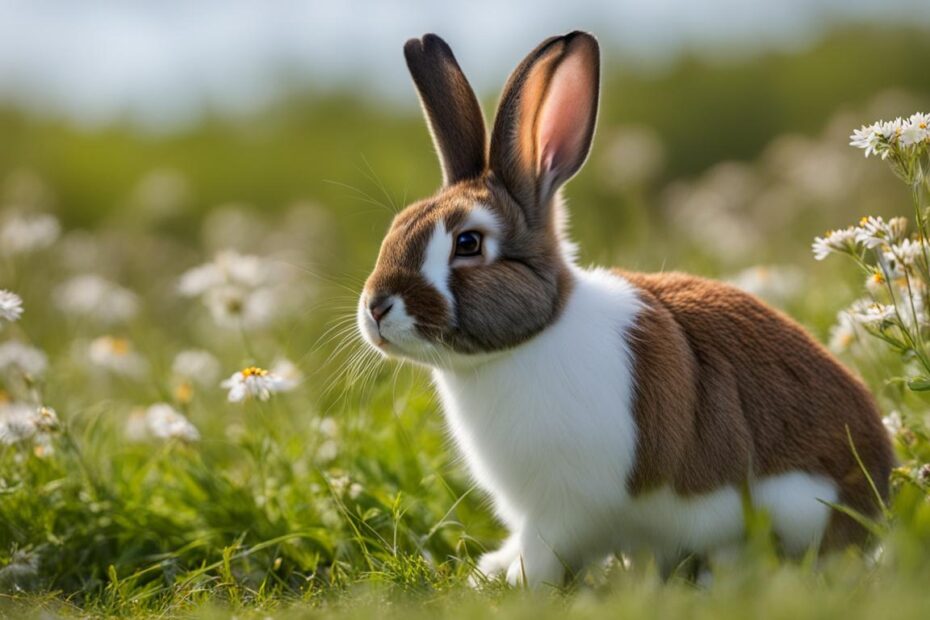Understanding rabbit behavior can be a fascinating journey for pet owners. From their quirky body language to their unique ways of communicating, rabbits have a rich repertoire of behaviors that can provide valuable insights into their emotions and well-being.
One intriguing behavior that rabbits display is flicking their back feet. This behavior can be puzzling to those unfamiliar with rabbit body language. In this article, we will delve into the world of rabbit behavior and explore the reasons behind this fascinating phenomenon.
Key Takeaways:
- Rabbits use various body movements to communicate and express themselves.
- Flicking back feet is a behavior that can indicate different emotions or messages.
- Understanding rabbit behavior is essential for strengthening the bond with your furry friend.
- Rabbit body language can provide valuable insights into their well-being.
- Observing and interpreting rabbit behaviors can enhance your interaction and care for your rabbit.
Rabbit Behavior: Decoding the Poker Face
Rabbits have a distinct set of behaviors that can be quite different from those of cats and dogs. As prey animals, rabbits have evolved to be masters of the poker face, making it difficult for humans to decipher their emotions. However, by observing their body language and behavior, we can begin to unravel the mysteries of rabbit communication and better understand our furry friends.
Understanding rabbit behavior is crucial for providing them with proper care and ensuring their well-being. While rabbits may not express their emotions through facial expressions like humans, they rely on subtle cues and body language to communicate their needs and feelings. By paying attention to these signals, we can gain insight into their state of mind and respond accordingly.
One significant aspect of rabbit behavior is their body language. Rabbits use various postures, movements, and vocalizations to convey different messages. For example, a relaxed and content rabbit will exhibit a relaxed body posture, with ears standing upright, and a calm expression. On the other hand, a stressed or frightened rabbit may flatten its ears against its back and exhibit a tense posture.
Rabbit Body Language
Rabbit body language includes a range of behaviors such as thumping, hopping, grooming, and binkies. Thumping is a behavior commonly associated with fear or alarm. When a rabbit feels threatened, it will stomp its hind legs on the ground to alert other rabbits to potential danger.
Hopping is a natural behavior for rabbits and serves as a means of locomotion and exercise. Rabbits hop when they are happy, playful, or exploring their environment. It is a positive sign that they are in good health and high spirits.
Grooming behavior is another vital aspect of rabbit communication. Rabbits groom themselves and each other as a way to bond and establish social connections. It is a sign of trust and affection between rabbits and their human companions.
“Rabbits have their unique ways of communicating and expressing themselves, and by understanding their body language, we can strengthen our bond with them and ensure their happiness.”
Finally, binkies are a joyful behavior exhibited by rabbits. It is when a rabbit suddenly leaps up, twists its body in the air, and kicks its back feet. Binkies are a clear sign of a happy and content rabbit, and witnessing this behavior can bring joy to any rabbit owner.
By decoding the poker face of rabbits and learning to interpret their body language, we can enhance our understanding of these fascinating creatures. It not only allows us to meet their needs but also strengthens the bond between rabbits and their human companions. So, the next time your furry friend flicks their back feet or exhibits any other behavior, take a moment to observe and understand what they may be trying to communicate.
Signs of a Happy Bunny: Cracking the Code
When it comes to understanding rabbit behavior, it’s important to know how to identify signs of a happy bunny. While rabbits may not show emotions in the same way humans do, they have their own ways of expressing happiness and contentment. By observing their body language and behavior, you can decipher the code and strengthen the bond with your furry friend.
Rabbits communicate a lot through their body language. Happy rabbits often display relaxed and comfortable postures. They may lie down with their back legs stretched out, indicating a sense of ease and security. Another positive sign is when a rabbit flops onto its side, fully exposing its belly. This behavior is a clear sign of trust and relaxation, as rabbits are vulnerable when they expose their belly in the presence of others.
Additionally, a happy rabbit will often engage in playful behaviors. They may binky, which is a joyful leap accompanied by twisting their body in the air and kicking their back feet. Binkies are a strong indication of happiness and excitement. Rabbits may also engage in zoomies, where they run and hop around energetically, seemingly filled with joy. These playful behaviors are a testament to their contentment and well-being.
Furthermore, a rabbit’s appetite can also be a clue to their happiness. A happy bunny will have a healthy appetite, eagerly munching on hay, vegetables, and pellets. They may show excitement and anticipation when it’s feeding time, eagerly approaching their food and displaying a sense of enjoyment while eating. A good appetite is a positive sign that your rabbit is in a happy state of mind.
Table: Signs of a Happy Rabbit
| Behavior | Meaning |
|---|---|
| Lying down with back legs stretched out | Relaxation and security |
| Flopping onto side, exposing belly | Trust and relaxation |
| Binky (joyful leap with twisting body and kicking back feet) | Happiness and excitement |
| Engaging in zoomies (running and hopping energetically) | Expressing joy and contentment |
| Healthy appetite and eagerness to eat | Positive state of mind |
By paying close attention to these signs and behaviors, you can gain a deeper understanding of your rabbit’s emotions and well-being. Remember, each rabbit is unique, so take the time to observe and learn the specific cues and signals that your furry friend exhibits when they are happy. This will not only strengthen your bond but also ensure that your rabbit is living a happy and fulfilling life.
Rabbit Behavior: The Joyful Leaps of a Happy Rabbit
When it comes to understanding rabbit behavior, one delightful display of happiness is the binky. A binky is a joyful leap that rabbits perform, accompanied by twisting their bodies in the air and kicking their back feet. It is a clear sign that your rabbit is feeling great and full of joy. By observing and recognizing this behavior, you can gain insight into your rabbit’s inner happiness.
The binky is not just a random, sporadic movement but a purposeful expression of joy. Rabbits often binky when they are feeling playful, excited, or content. It is their way of celebrating life and expressing their genuine happiness. Witnessing a binky can be a heartwarming experience that shows your rabbit feels safe, secure, and loved in their environment.
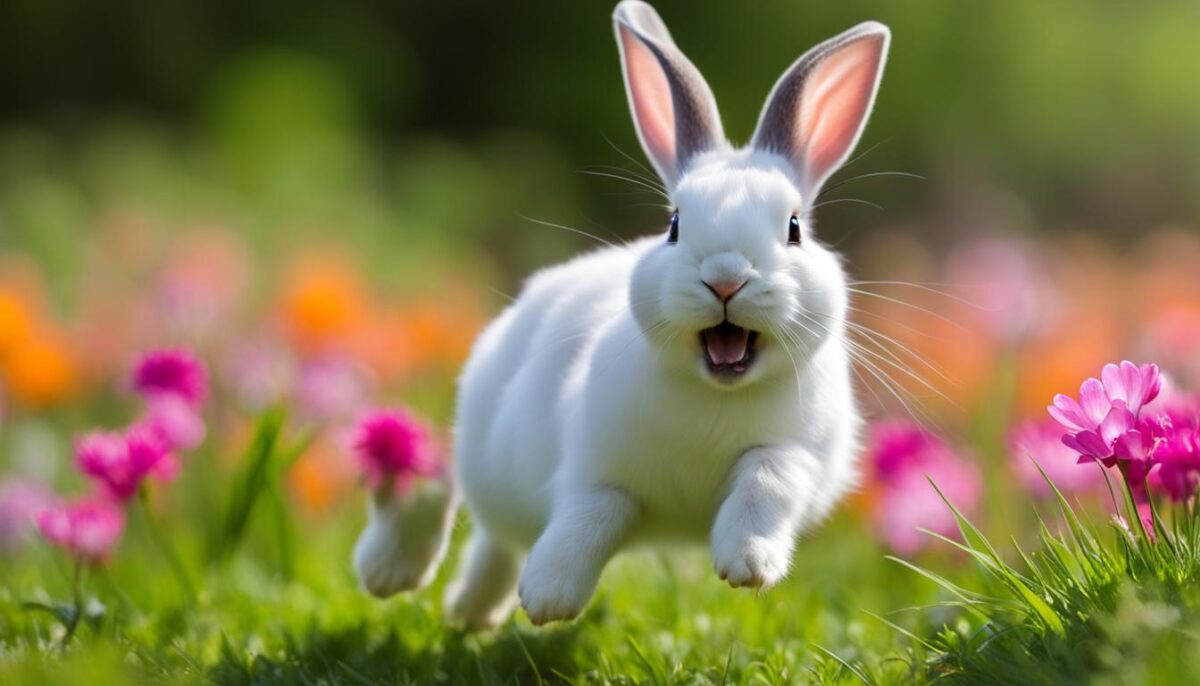
Table: Common Rabbit Behaviors
| Behavior | Meaning |
|---|---|
| Binky | A sign of happiness and contentment |
| Thumping | A warning sign or feeling of danger |
| Hopping | Indicates good health and high spirits |
| Licking | Can indicate affection or dominance |
| Dancing | A display of joy and enthusiasm |
| Staring | Signifies affection and a bond |
As a rabbit owner, witnessing a binky is a rewarding experience. It shows that your rabbit is thriving and enjoying their life. Encouraging an environment that promotes your rabbit’s physical and mental well-being can increase the likelihood of witnessing more binkies. Provide ample space for exercise, enrich their living areas with toys and tunnels, and ensure they feel safe and secure in their habitat. By nurturing their happiness, you can create a stronger bond with your furry friend.
Rabbit Behavior: Hopping and Its Impact on Rabbit Health
Hopping is a natural behavior for rabbits and plays a crucial role in their overall health and well-being. Rabbits are built for hopping, with powerful hind legs designed for swift and agile movement. This unique form of locomotion not only allows them to explore their surroundings but also helps maintain their muscular strength and joint flexibility. Understanding the significance of hopping can provide valuable insights into your rabbit’s physical fitness.
Regular hopping exercise helps rabbits maintain a healthy weight and prevents obesity, a common issue in domesticated rabbits. It promotes cardiovascular health and enables proper digestion by stimulating the gastrointestinal tract. Additionally, hopping allows rabbits to express their natural instincts and release excess energy, reducing the likelihood of destructive behavior.
To ensure your rabbit’s optimal health, it is essential to provide them with enough space and opportunities for hopping. A spacious enclosure or access to a secure outdoor area allows for unrestricted movement and encourages regular exercise. Creating an enriching environment with tunnels, ramps, and safe obstacles can also stimulate hopping and keep your rabbit mentally engaged.
The Benefits of Hopping for Rabbits:
- Improved muscle strength and joint flexibility
- Cardiovascular health maintenance and weight management
- Stimulation of the gastrointestinal tract
- Expression of natural instincts and release of excess energy
“Regular hopping exercise helps rabbits maintain a healthy weight and prevents obesity, a common issue in domesticated rabbits.”
Remember, it’s vital to monitor your rabbit’s hopping behavior for any signs of discomfort or difficulty. If you notice any changes in their hopping pattern, such as limping or reluctance to hop, consult your veterinarian for a thorough examination. By understanding the importance of hopping and supporting your rabbit’s natural behavior, you can contribute to their overall health and happiness.
Licking: Love and Dominance
Licking is a fascinating behavior in rabbits that serves multiple purposes, from displaying affection to establishing dominance within their social hierarchy. Understanding the nuances of licking can provide valuable insights into your rabbit’s behavior and strengthen your bond with them.
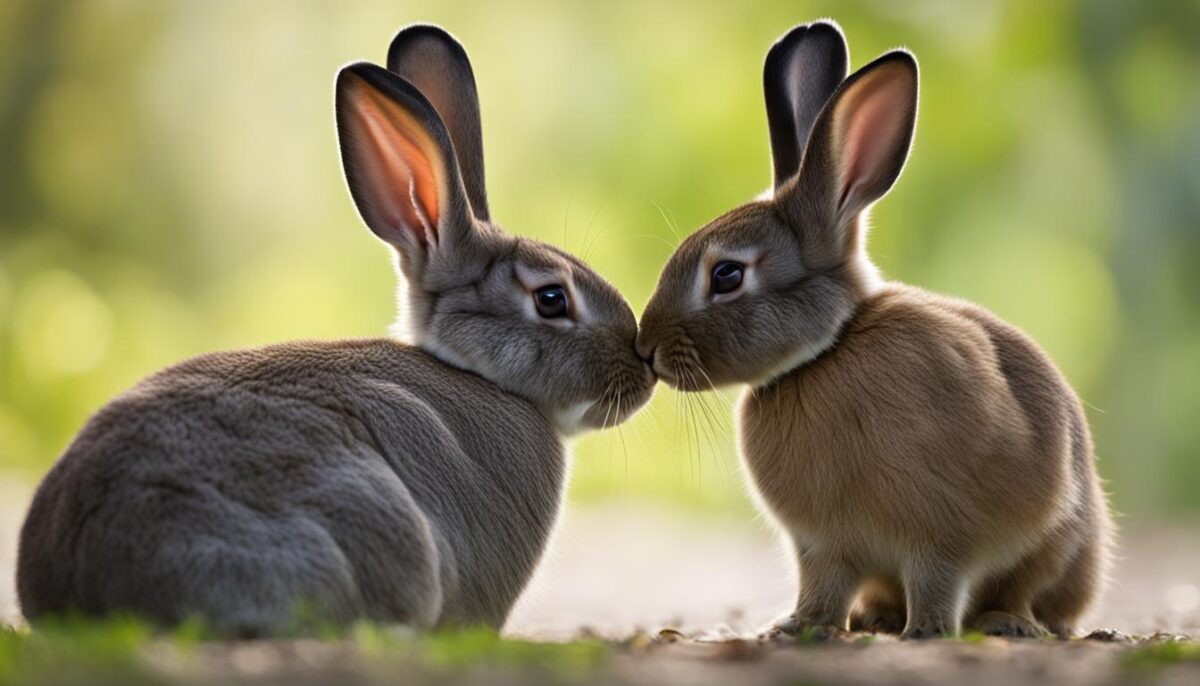
Expressing Love and Affection
When your rabbit licks you, it is a clear sign of their affection and acceptance. Licking is a form of grooming behavior that rabbits engage in to keep themselves and their bonded companions clean. It is their way of showing love and care. By reciprocating their affection through gentle petting and grooming, you can reinforce the bond between you and your furry friend.
Establishing Dominance
In rabbit social dynamics, licking can also be a display of dominance. Dominant rabbits may lick their subordinates as a way to assert their authority and reinforce their position in the hierarchy. If your rabbit licks you excessively or tries to lick your face, it could be a sign that they are attempting to establish dominance over you. It’s important to set boundaries and establish yourself as the primary caregiver and leader in your rabbit’s life.
Observing Context and Body Language
To interpret your rabbit’s licking behavior accurately, it’s crucial to consider the context and observe their body language. Pay attention to the intensity and frequency of the licking, as well as the accompanying behaviors. If your rabbit appears relaxed, with ears in a neutral position and a calm demeanor, their licking is likely an expression of love and affection. On the other hand, if your rabbit seems tense or exhibits other signs of dominance like mounting or nipping, their licking may be a display of dominance.
In summary, licking is a complex behavior in rabbits that can signify both love and dominance. By carefully observing your rabbit’s body language and understanding the context, you can decipher the meaning behind their licking behavior and establish a harmonious relationship based on trust and respect.
Rabbit Behavior: Dancing, the Lively Moves of a Happy Bunny
When it comes to expressing joy and excitement, rabbits have a unique way of showing it – through dancing! Dancing is a behavior exhibited by rabbits that involves quick and lively movements. These delightful moves are often associated with courtship or simply a display of happiness and enthusiasm. By observing your rabbit’s dance-like behaviors, you can witness their inner joy and connect on a deeper level.
“Dancing is a unique behavior that rabbits use to communicate their happiness and contentment,” says Dr. Emily Thompson, a rabbit behavior expert. “It’s a beautiful sight to see and a testament to the positive environment and strong bond you’ve established with your furry friend.”
Rabbits may engage in various dance-like movements, including leaps, twists, and quick dashes. They may also kick their back feet in the air as if they’re celebrating. These lively moves showcase the rabbit’s agility and are often accompanied by playfulness and high energy.
As a pet owner, witnessing your rabbit’s dance is not only heartwarming but also an indication that they are in good health and experiencing a state of happiness. It is important to create a stimulating and enriching environment for your rabbit to encourage these joyful behaviors.
| Rabbit Dancing Behaviors | Description |
|---|---|
| Leaping | Rabbits may suddenly leap into the air, showcasing their agility and joy. |
| Twisting | During a dance, rabbits may twist their bodies in mid-air, adding an element of flair. |
| Kicking Back Feet | Rabbits often kick their back feet energetically, emphasizing their excitement and happiness. |
By recognizing and appreciating your rabbit’s dancing behaviors, you can create a positive and fulfilling relationship with your furry companion. Encourage their natural instincts and provide them with ample space and opportunities for physical activity, as this will help bring out the dance moves that express their vibrant personality.
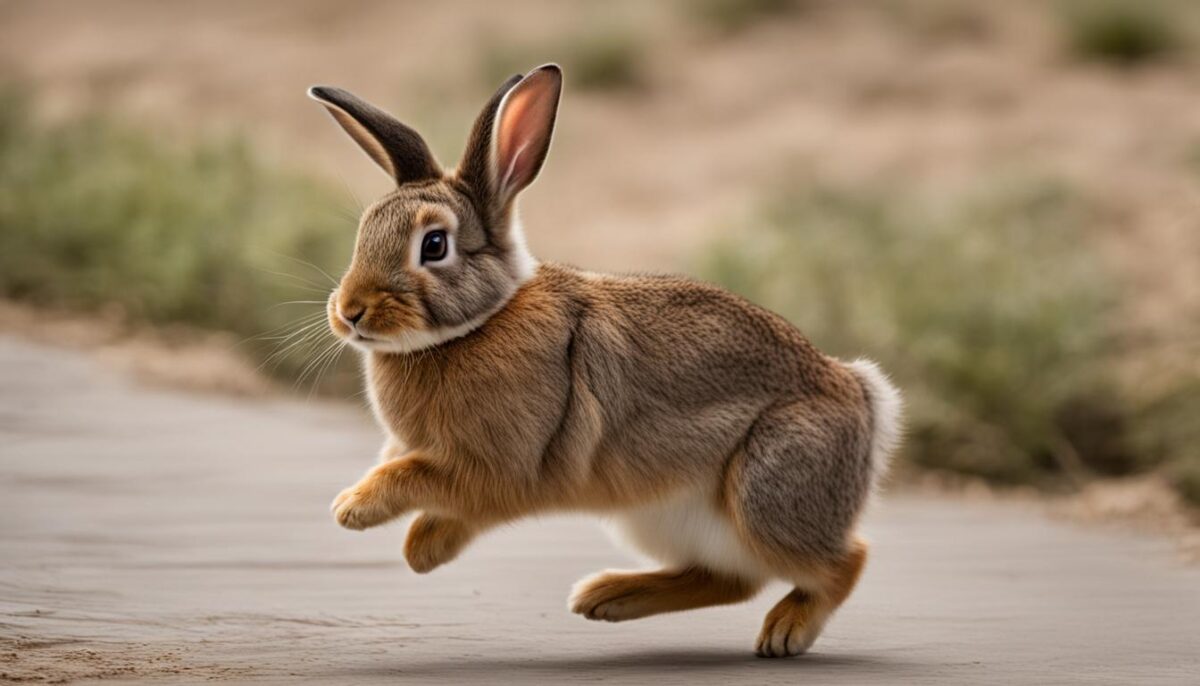
Creating a Dance-Friendly Environment
Here are some tips to create a dance-friendly environment for your rabbit:
- Provide plenty of space for your rabbit to hop and run freely.
- Include toys and tunnels to stimulate their curiosity and encourage playful movements.
- Set up safe obstacles for your rabbit to navigate, such as low hurdles or hurdles.
- Ensure your rabbit’s living space is enriched with various textures and surfaces to explore.
Remember, each rabbit has their own unique personality and preferences, so pay attention to what activities and stimuli your rabbit enjoys the most. By creating an environment that promotes physical and mental stimulation, you can encourage your bunny to dance their way into a state of pure happiness.
The Language of Staring and Nudging
When it comes to rabbit behavior, staring and nudging are two intriguing forms of communication that can provide insights into their emotions and interactions with humans. Understanding these behaviors is essential for strengthening the bond between you and your furry friend. Let’s delve into the language of staring and nudging and explore what they mean.
Staring:
When a rabbit gazes or stares at you, it is their way of expressing affection and a sign of the bond between you. It shows that your rabbit feels comfortable and secure in your presence. You may notice your rabbit’s eyes widening or their ears perking up while they maintain eye contact. This behavior can be especially heartwarming, as it indicates that your rabbit trusts and enjoys your company.
Nudging:
On the other hand, when a rabbit nudges you, it can mean different things depending on the context. Nudging is a gentle push with their nose or head, and it is a way for rabbits to seek attention or indicate their desire to play. It’s their way of saying, “Hey, pay attention to me!” or “Let’s have some fun together!” It’s important to respond to your rabbit’s nudges and provide them with the interaction they’re seeking, whether it’s a gentle pat or some playtime.
“Staring and nudging are fascinating behaviors in rabbits that showcase their unique ways of communicating with humans. Understanding these subtle cues can enhance the bond between you and your rabbit.”
Creating a Strong Connection
By being attentive to the language of staring and nudging, you can better understand your rabbit’s needs and desires. Responding positively to their gaze and reciprocating their nudges will strengthen your bond and build trust. Remember to provide your rabbit with ample opportunities for play, exercise, and social interaction to keep them happy and engaged.
In summary, staring and nudging are meaningful behaviors that rabbits use to communicate with humans. Staring signifies affection and trust, while nudging seeks attention and play. These behaviors offer a glimpse into the unique language of rabbits and provide a foundation for a strong and fulfilling relationship with your furry companion.
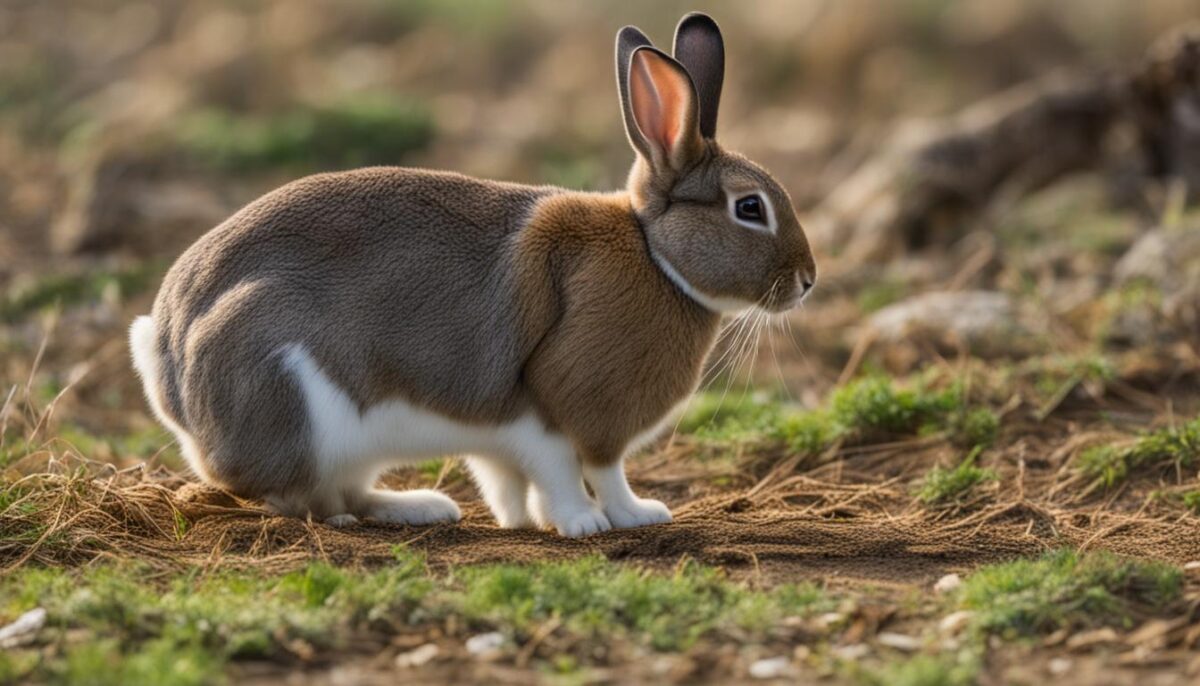
| Behavior | Meaning |
|---|---|
| Staring | Expresses affection and trust |
| Nudging | Seeks attention and play |
Thumping and Other Signs of Discontent
Rabbits have various ways of expressing their discontent and fear. One notable behavior is thumping, where rabbits rhythmically thump their hind feet against the ground as a warning sign. This behavior is often triggered by perceived danger or anxiety. Additionally, rabbits may engage in hiding, growling, or even screaming when they are extremely distressed. Being attuned to these signs can help you identify and address any sources of unease for your rabbit.
Thumping is a form of communication used by rabbits to alert others of potential threats. It is their way of saying, “Hey, there’s danger nearby!” When a rabbit feels threatened or senses something suspicious, they will forcefully hit their hind feet on the ground, creating a loud thumping sound. This behavior not only warns other rabbits in the vicinity but also serves as a defense mechanism to scare away predators.
“Thumping is one of the most distinct and easily recognizable behaviors in rabbits,” says Dr. Jane Carter, a veterinarian specializing in rabbit care. “It’s their way of quickly communicating their unease or fear to their surroundings. As prey animals, rabbits rely on their keen senses and instinctual behaviors to stay safe.”
In addition to thumping, rabbits may resort to hiding when they feel threatened or stressed. They seek out secluded spots in their environment, such as under furniture or in small nooks, to create a sense of security. Hiding allows rabbits to minimize their exposure to potential danger and gives them a safe space to calm down and relax.
While thumping and hiding are common signs of discontent in rabbits, it is important to note that these behaviors can also indicate underlying health issues or environmental factors. If your rabbit displays these behaviors frequently or excessively, it is advisable to consult with a veterinarian to rule out any medical conditions that may be causing distress.
| Behavior | Meaning |
|---|---|
| Thumping | Potential danger or anxiety |
| Hiding | Feeling threatened or stressed |
| Growling | Expressing fear or aggression |
| Screaming | Extreme distress or pain |
By understanding and recognizing these signs of discontent in rabbits, you can take appropriate measures to create a safe and comfortable environment for your furry friend. Providing them with hiding spots, minimizing stressors, and maintaining a routine of gentle and positive interactions can help alleviate their anxiety and promote their overall well-being.
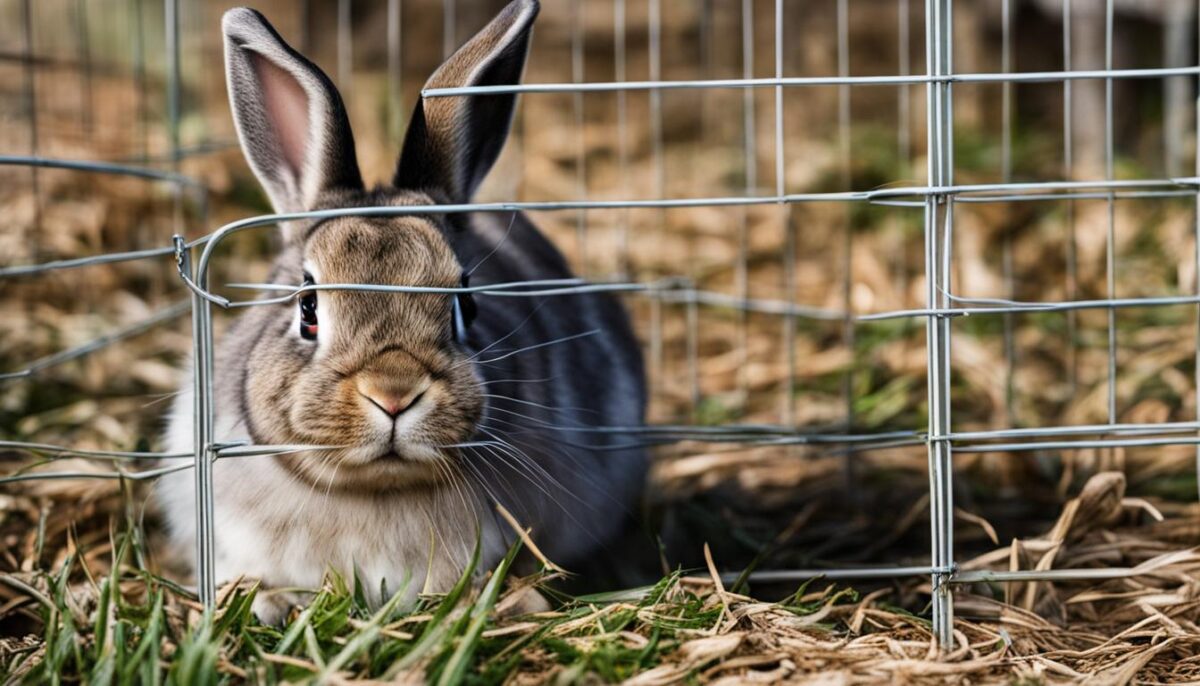
Key Takeaways
- Thumping is a behavior where rabbits rhythmically hit their hind feet on the ground as a warning sign of danger or anxiety.
- Hiding is a common response in rabbits when they feel threatened or stressed, providing them with a sense of security.
- Growling and screaming are other signs of distress in rabbits that should be addressed and investigated further.
- Understanding and addressing signs of discontent in rabbits can help create a safe and comfortable environment for them.
Conclusion
In conclusion, understanding rabbit behavior is crucial for building a strong bond with your furry friend. By interpreting their body language and communication cues, you can gain insights into their emotions and ensure their well-being.
Rabbits have a unique way of expressing themselves, and by observing their behavior, you can appreciate their individuality and respond to their needs effectively. Remember to pay attention to signs of happiness, such as binkies and dancing, as well as signs of discontent, such as thumping and hiding.
Interpreting rabbit body language is a continuous learning process, as each rabbit has its own personality and preferences. By taking the time to understand your rabbit’s unique behaviors, you can establish a deeper connection and provide them with a happy and fulfilling life.
FAQ
How can I tell if my rabbit is happy?
While rabbits don’t show facial expressions like humans, there are subtle cues to look for. Joyful behaviors such as binkies (leaping and kicking back feet) and energetic hopping are signs of a happy rabbit.
What does it mean when my rabbit licks me?
Licking can be a sign of affection and acceptance from your rabbit. However, it can also be a way for rabbits to establish dominance within their social hierarchy.
Why do rabbits dance?
Dancing is a happy behavior exhibited by rabbits, often associated with courtship or simply a display of joy.
What does it mean when my rabbit stares at me?
Staring is a sign of affection and a bond between you and your rabbit. It shows that they trust and have a connection with you.
Why does my rabbit thump its feet?
Thumping is a warning sign that rabbits use when they perceive danger or feel anxious. It’s their way of signaling potential threats.
How can I understand my rabbit’s body language better?
By observing their behavior and body language, such as binkies, hopping, licking, and other cues, you can gain insights into your rabbit’s emotions and well-being.


